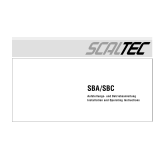Page is loading ...

1
Installation Instructions
Montageanleitung
Instructions de montage
Instrucciones de montaje
OPTION 013 DATA INTERFACE
38752
INSTALLATION INSTRUCTIONS FOR THE 013 DATA INTERFACE OPTION FOR AE BALANCES
General information
A METTLER TOLEDO AE balance can be integrated into an IEEE488 bus system by using the bidirectional 013 Data Interface
Option.
The data interface description entitled, “The 013 Bidirectional Data Interface for AE balances (IEEE/HB-IB)”;
Order No. 701326 available from METTLER TOLEDO can provide you with information about data transfer with non-METTLER
TOLEDO instruments as well as about hardware and software definitions. The description is very strongly recommended if you
intend to develop programs for balance control on your own.
Opening the housing
This is necessary only if a configuration that is different from the factory
setting must be set.
Factory setting: data exchange with Service Request (SRQ)/send on transfer/
hardware reset if malfunction occurs/cable shielding grounded.
– To open the housing, remove the screws from the four corners
(arrows). Turn the housing over and lift off cover.
Configuring the data interface
– Operating mode switches (1): do not change the position of switch
1.
Switches 2 and 4 are set to OFF at the factory: switch 3 is set to ON.
Switch ON OFF
1 If program is on If program is on
single chip micro- external
processor EPROM
2 Data exchange with Data exchange with
no SRQ (Service SRQ (Service
Request)* Request)
3 Hardware reset if No hardware reset
malfunction occurs if malfunction occurs
4 Send Continuous Send on Transfer
*) Data transfer controlled by evaluation of the balance status byte (see
Table below).
– Cable shielding (Pin 12): coding plug (2) is placed on Pins 2 and
3 at the factory, i.e., the cable shielding is grounded. It can also be
placed on Pins 1 and 2 (floating).
© Mettler-Toledo GmbH 2000 701325 Printed in Switzerland 0006/33.33
Mettler-Toledo GmbH, Laboratory & Weighing Technologies, CH-8606 Greifensee, Switzerland
Phone +41-1-944 22 11, Fax +41-1-944 30 60, Internet: http://www.mt.com
Subject to technical changes and to the availability
of the accessories supplied with the instruments.
Technische Änderungen und Änderungen im
Lieferumfang des Zubehörs vorbehalten.
Sous réserve de modifications techniques
et de disponibilité des accessoires.
Reservadas las modificaciones técnicas
y la disponibilidad de los accesorios.
P701325
English
Deutsch
Seite 4
Français
Page 7
Español
Página 10

2
Leerseite
Changing the power-line voltage setting
Note: The power-line voltage must be set on the housing of the data interface.
The voltage selector switch can be set to the proper range by using a
screwdriver:
Switch position Voltage range
115 V 92…132 V
220 V 184…265 V
Microfuse: 100 mA slow-blowing
Installing the data interface housing
– Disconnect the power cable from the balance.
– Insert the tabs (6) on the housing into the openings on the rear of the
balance.
– Plug in the ribbon cable connector (7). The loop of the ribbon cable
must lead in from the bottom.
– Swing housing up against the balance until the power connector (8) is
plugged in completely.
– Reconnect source by plugging the power cable back into connector (9).
Connecting to the IEEE488 bus
The 013 Data Interface Option conforms to the IEEE488 standard. The balance
can be addressed from a control instrument (Controller) as a “Talker” and a
“Listener”.
– The instrument address or the “Talker Only” function is defined with bit
switches (11) (binary 0…30 and TON).
TON (Talker Only): the balance can only transmit (Talker). Addressing
cannot be carried out.
– Connect the IEEE488 cable to socket (12).
– If data transfer is to be triggered by hand (“Send on Transfer” mode),
connect the handkey (42500) or foot pedal (46278) to sockets (10).
Removing the data interface
– It is absolutely necessary to first disconnect the power cable from the data interface housing.
– Carefully swing housing straight back and down.
– Disconnect the ribbon cable connector (7).
– Unhook the tabs (6) from the balance rear wall.
– Cover the ribbon cable socket on the balance rear wall with the cover.
Device Address 15

3
STATUS BYTE of AE balances
Send value
(Transmit next stable weighing result)
Send Immediate value Request of
(Immediately send a weighing result) measuring
value
Send Immediate value and Repeat
(Send all weighing results)
Display text
(Bring “text” to balance display)
Display text; symbol Conrol of
(Bring “text” and “symbol” to balance display) balance
display
Display reset
(Return to display of weighing result)
Remot enable (1) Influence of
(Switch on remote control) control bar on
balance
Remote disable (0)
(Switch off remote control)
Clear Reset of all
(Reset balance and data interface) instructions
DATA FORMAT at the data output of the AE balance
Unit, g
Data block, weighing result
Identification block
Transfer triggered by pressing
button
Stable result
Unstable result
Invalid result
Brief information about bidirectional operation
AE balances are equipped with a full duplex data interfaces with the 013 Option, i.e., the balance can not only transmit weighing
results to a data receiver, but also receive, evaluate and carry out certain control instructions.
These instructions are listed below. A detailed explanation of these instructions can be found in the data interface description entitled,
“The 013 Bidirectional Data Output Option for AE balances (IEEE488/HP-IB)”, Order Number 701326 available from METTLER
TOLEDO.
/: space
INSTRUCTION SET for control of the AE balance
Tare Tare
Ready for command (RFC)
Message available (MAV)
SERVICE REQUEST (SR)
Ø = 0 or 1; X = don‘t care (not defined)
If bit 4 = 1 Balance is ready for instruction
If bit 5 = 1 Balance holding result ready
If bit 6 = 1 “Service Request” bit (IEEE488)
/


